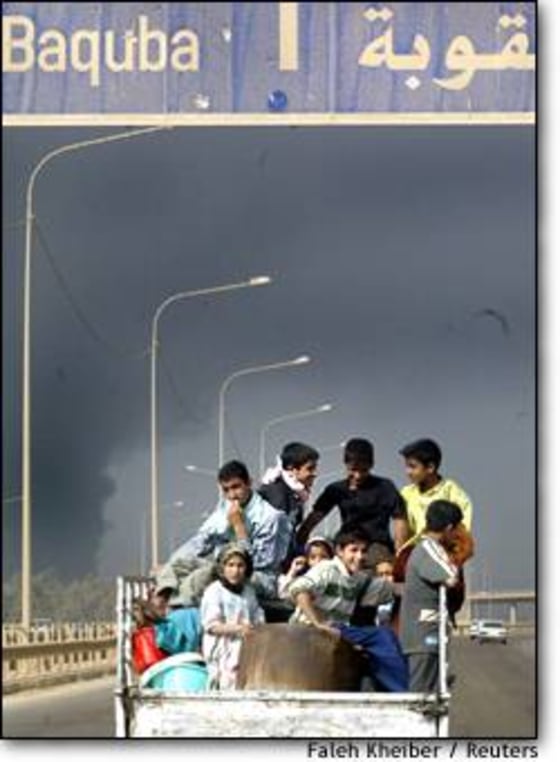Thousands of residents were fleeing north from the Iraqi capital in a stream of bumper-to-bumper vehicles Friday after U.S. troops seized the city’s international airport and electrical power remained off for a second straight day. But a televised appearance by President Saddam Hussein being cheered by crowds in a street here may rally support for his government.
There was a tense athmophere Friday night, as U.S. airstrikes continued. Anticipating an intense battle, Iraqi civilians packed food and belongings into trucks, buses and cars in a mass exodus during the day Friday. Some witnesses said the lines of vehicles extended for up to six miles.
Despite the conflict, traffic on the streets was about normal early Friday, the Muslim day of rest, and many shops were open.
Bakeries, grocers and barber shops — some without power — appeared to be doing a brisk business. There were long lines at gas stations, and some buses were running.
By late afternoon, gas station lines grew much longer, and some neighborhoods, especially those in the south, were quieter than usual.
SPIN AND THREATS
The Iraqi information minister called a news conference earlier and promised that the U.S. troops who have taken the city’s main airport are going to witness “unconventional” military action during the night. He denied that the Iraqis would use chemical or biological weapons but said the U.S. forces would face what he called “martyrdom tactics” and guerrilla war.
Soon afterward, the appearance of Saddam seemed to surprise residents here. In pictures shown on Iraqi television, he was seen walking through an excited crowd, standing on a car and waving. The pictures appeared to have been taken recently because huge plumes of black smoke can be seen in the background.
Those television images are going to cause a lot of consternation in London and Washington, where officials hoped that the Iraqi leader was dead or wounded. But it’s unclear how many people in Baghdad will be able to see them since most of the city is still without electrical power.
InsertArt(1852018)On Thursday evening, Iraqi Deputy Prime Minister Tariq Aziz was on television, denying that coalition forces were at the gates of Baghdad, when the light in the room flickered and then went dark. The U.S. denied targeting the power grid, and some parts of the city regained electrical service Friday.
ITN’s John Ray reported that at the airport itself, the hulks of Iraqi tanks and the body of an Iraqi soldier were all that remained of a column that stormed out to defend the airport early Friday. They were stopped in their tracks by the U.S. forces.
Some civilian airport workers surrendered to the Americans. Many now wonder if the surrender of Saddam’s regime can be far behind.
AT THE HOSPITALS
Health Minister Omeed Medhat Mubarak said hospitals in the capital were swamped with wounded.
At al-Yarmouk hospital, doctors and nurses scrambled to cope with the rush of casualties, including civilians and soldiers from the Republican Guard. The injured could be heard crying in pain. Those too weak to talk pointed to their bloodied bandages and wounds.
The hospitals had generators so they could operate despite the power outage — the first widespread outage in the capital since the war began March 20.
A sustained loss of electricity would mean the disruption of water supply and sewage, which could spread disease at a time of rising temperatures. Parts of this city of 5 million had no running water.
Some of the injured at al-Yarmouk said they were from the Furat and al-Radwaniyah districts, both close to the airport. People at the hospital said dozens had been killed in the two districts, but that could not be confirmed.
“It was a fierce battle last night and today,” said 23-year-old Republican Guard soldier Omar Bahaeldeen Khalil from his hospital bed.
(Neal Connery is an ITN correspondent in Baghdad. ITN correspondents John Irvine and John Ray, Reuters and the Associated Press also contributed to this report.)
